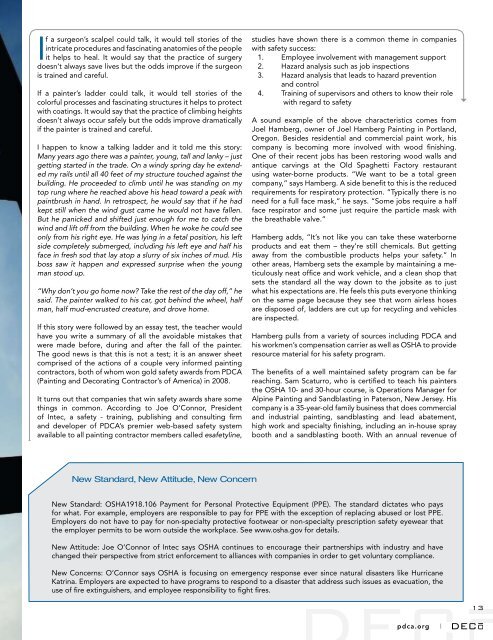n o v/d e c • 2 0 0 8 - Subscribe
n o v/d e c • 2 0 0 8 - Subscribe
n o v/d e c • 2 0 0 8 - Subscribe
Create successful ePaper yourself
Turn your PDF publications into a flip-book with our unique Google optimized e-Paper software.
If a surgeon’s scalpel could talk, it would tell stories of the<br />
intricate procedures and fascinating anatomies of the people<br />
it helps to heal. It would say that the practice of surgery<br />
doesn’t always save lives but the odds improve if the surgeon<br />
is trained and careful.<br />
If a painter’s ladder could talk, it would tell stories of the<br />
colorful processes and fascinating structures it helps to protect<br />
with coatings. It would say that the practice of climbing heights<br />
doesn’t always occur safely but the odds improve dramatically<br />
if the painter is trained and careful.<br />
I happen to know a talking ladder and it told me this story:<br />
Many years ago there was a painter, young, tall and lanky – just<br />
getting started in the trade. On a windy spring day he extended<br />
my rails until all 40 feet of my structure touched against the<br />
building. He proceeded to climb until he was standing on my<br />
top rung where he reached above his head toward a peak with<br />
paintbrush in hand. In retrospect, he would say that if he had<br />
kept still when the wind gust came he would not have fallen.<br />
But he panicked and shifted just enough for me to catch the<br />
wind and lift off from the building. When he woke he could see<br />
only from his right eye. He was lying in a fetal position, his left<br />
side completely submerged, including his left eye and half his<br />
face in fresh sod that lay atop a slurry of six inches of mud. His<br />
boss saw it happen and expressed surprise when the young<br />
man stood up.<br />
“Why don’t you go home now? Take the rest of the day off,” he<br />
said. The painter walked to his car, got behind the wheel, half<br />
man, half mud-encrusted creature, and drove home.<br />
If this story were followed by an essay test, the teacher would<br />
have you write a summary of all the avoidable mistakes that<br />
were made before, during and after the fall of the painter.<br />
The good news is that this is not a test; it is an answer sheet<br />
comprised of the actions of a couple very informed painting<br />
contractors, both of whom won gold safety awards from PDCA<br />
(Painting and Decorating Contractor’s of America) in 2008.<br />
It turns out that companies that win safety awards share some<br />
things in common. According to Joe O’Connor, President<br />
of Intec, a safety - training, publishing and consulting firm<br />
and developer of PDCA’s premier web-based safety system<br />
available to all painting contractor members called esafetyline,<br />
New Standard, New Attitude, New Concern<br />
studies have shown there is a common theme in companies<br />
with safety success:<br />
1. Employee involvement with management support<br />
2. Hazard analysis such as job inspections<br />
3. Hazard analysis that leads to hazard prevention<br />
and control<br />
4. Training of supervisors and others to know their role<br />
with regard to safety<br />
A sound example of the above characteristics comes from<br />
Joel Hamberg, owner of Joel Hamberg Painting in Portland,<br />
Oregon. Besides residential and commercial paint work, his<br />
company is becoming more involved with wood finishing.<br />
One of their recent jobs has been restoring wood walls and<br />
antique carvings at the Old Spaghetti Factory restaurant<br />
using water-borne products. “We want to be a total green<br />
company,” says Hamberg. A side benefit to this is the reduced<br />
requirements for respiratory protection. “Typically there is no<br />
need for a full face mask,” he says. “Some jobs require a half<br />
face respirator and some just require the particle mask with<br />
the breathable valve.”<br />
Hamberg adds, “It’s not like you can take these waterborne<br />
products and eat them – they’re still chemicals. But getting<br />
away from the combustible products helps your safety.” In<br />
other areas, Hamberg sets the example by maintaining a meticulously<br />
neat office and work vehicle, and a clean shop that<br />
sets the standard all the way down to the jobsite as to just<br />
what his expectations are. He feels this puts everyone thinking<br />
on the same page because they see that worn airless hoses<br />
are disposed of, ladders are cut up for recycling and vehicles<br />
are inspected.<br />
Hamberg pulls from a variety of sources including PDCA and<br />
his workmen’s compensation carrier as well as OSHA to provide<br />
resource material for his safety program.<br />
The benefits of a well maintained safety program can be far<br />
reaching. Sam Scaturro, who is certified to teach his painters<br />
the OSHA 10- and 30-hour course, is Operations Manager for<br />
Alpine Painting and Sandblasting in Paterson, New Jersey. His<br />
company is a 35-year-old family business that does commercial<br />
and industrial painting, sandblasting and lead abatement,<br />
high work and specialty finishing, including an in-house spray<br />
booth and a sandblasting booth. With an annual revenue of<br />
New Standard: OSHA1918.106 Payment for Personal Protective Equipment (PPE). The standard dictates who pays<br />
for what. For example, employers are responsible to pay for PPE with the exception of replacing abused or lost PPE.<br />
Employers do not have to pay for non-specialty protective footwear or non-specialty prescription safety eyewear that<br />
the employer permits to be worn outside the workplace. See www.osha.gov for details.<br />
New Attitude: Joe O’Connor of Intec says OSHA continues to encourage their partnerships with industry and have<br />
changed their perspective from strict enforcement to alliances with companies in order to get voluntary compliance.<br />
New Concerns: O’Connor says OSHA is focusing on emergency response ever since natural disasters like Hurricane<br />
Katrina. Employers are expected to have programs to respond to a disaster that address such issues as evacuation, the<br />
use of fire extinguishers, and employee responsibility to fight fires.<br />
pdca.org |<br />
13








